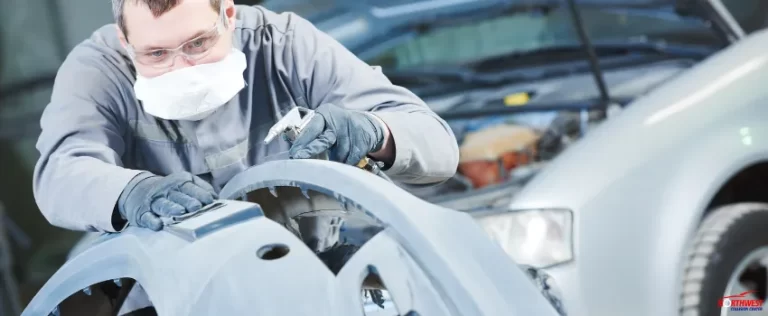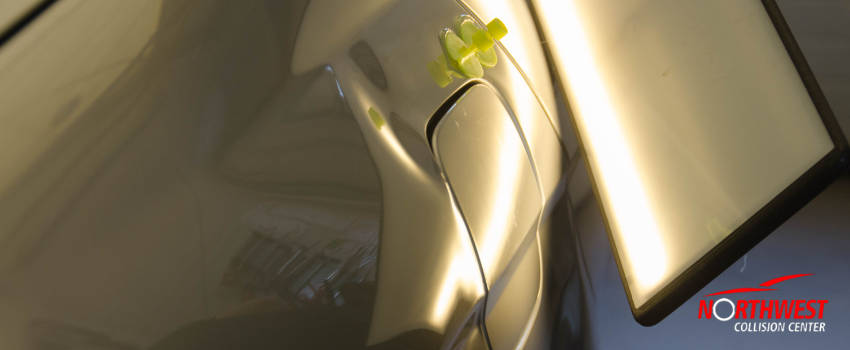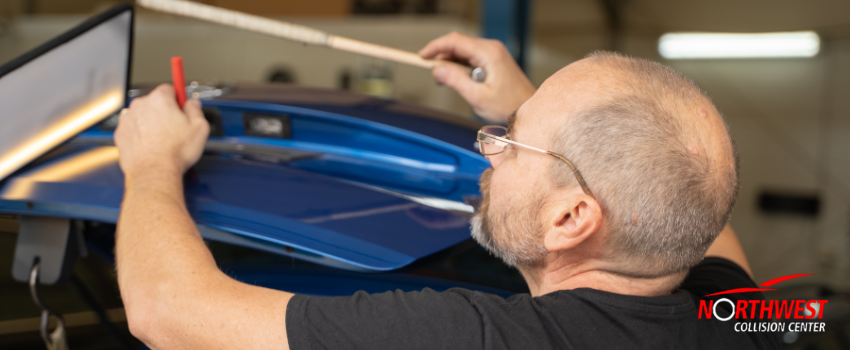If you’ve experienced getting a minor scrape on your car, it’s natural to feel a little disturbed. Fortunately, thanks to advancements in technology, several solutions have now become readily available.
When dealing with a shallow auto dent that hasn’t damaged the paint, one particularly effective repair approach is paintless dent removal, but what is it exactly? As the name suggests, it’s a method of rectifying car dents without the need for a body filler.
What is paintless dent repair?
Often referred to as PDR, this is a specialized technique designed to remove car dents and restore the appearance of a vehicle’s exterior without the need for traditional bodywork or repainting. The method involves a meticulous massaging of the dent from the interior by accessing the backside of the affected area.
Trained PDR technicians use a combination of specialized tools and precise pressure to gradually reshape a car’s metal panel so it returns to its initial form. This makes the PDR process highly effective when it comes to handling those annoying yet superficial dents.
How did PDR start?
The origins of paintless dent repair can be traced back to the 1940s when Oskar Flaig, a skilled German auto technician, devised a method for massaging out dents from behind a car panel without damaging the paint. The technique soon gained popularity in the auto repair industry as a time-saving and cost-effective approach to dent management.
Over the next few decades, PDR continued to evolve, with various technicians refining the process. By the 1980s, paintless dent repair had gained significant recognition in the United States, with its basic process increasingly being adopted by different car body shops.
How PDR Works
The paintless dent repair process is meticulous and involves the gentle manipulation of a vehicle’s metal panels so they can be restored to their original shape without affecting the paint. Skilled technicians begin the work by accessing the interior side of the dent and strategically employing an array of specialized tools. This process allows them to apply controlled pressure and leverage on the dent while gradually coaxing the metal back to its pre-damaged state.
The technique requires a keen understanding of the physical properties of metals and a trained eye to ensure that the repair is precise and seamless. The result is a carefully restored exterior surface that maintains the vehicle’s factory finish.
What are the techniques for paintless dent repair?
Listed below are the techniques commonly applied in a typical PDR work:
1. Pushing from Behind
This technique involves accessing the backside of the dent and applying controlled pressure using specialized blunt tools. By strategically pushing against the dent’s center and gradually working outward, technicians can carefully reshape the metal without damaging the paint of the car.
2. Glue Pulling
Glue pulling or glue pull repair utilizes adhesive tabs and a pulling device to gently lift the dent off from the panel’s surface. A specialized hot glue is applied to the tab, which is then affixed to the dent. As the pulling device is engaged, the dent gets gradually lifted.
3. Tapping Down
For car dents that have resulted in raised areas on the metal, tapping down is usually employed. Under this technique, technicians use specialized tools to gently tap the raised spots back into alignment with the surrounding surface, achieving a smooth and uniform finish.
4. Reflection Boards
Reflection boards are used to visualize the distortion caused by a dent’s impact. By carefully analyzing the reflection of light on the panel, technicians can pinpoint the exact location of the dent and ensure precise manipulation during the paintless dent repair process.
What does a paintless dent repair technician do?
A paintless dent repair technician is a highly trained professional who specializes in the intricate art of restoring a car’s exterior to its original condition without the need for a new paint finish. A skilled PDR technician usually begins the work by carefully assessing the damage and determining the most appropriate technique to use based on factors like dent size, location, and access points.
Using an array of specialized tools, the technician will strategically manipulate, massage, and push the dented area until a reshaping of the metal back to its pre-damaged state takes place. The technician’s acute understanding of metal behavior and the precise application of the needed pressure ensures that the repair comes out as a success.
Benefits of Paintless Dent Repair
The benefits of opting for paintless dent repair include the following:
1. Minimal Cost
Paintless dent repair is notably less expensive when compared to traditional repair methods. With PDR, there’s no need for materials like paint and fillers, as well as the labor-intensive steps associated with repainting.
2. Quick Turnaround Time
PDR boasts of a remarkably fast completion time. Since it doesn’t involve the intricate processes of sanding, priming, and painting, the paintless dent repair process can often be completed in a matter of hours.
3. Preserved Resale Value
Keeping a car’s exterior in its original condition is paramount for maintaining its resale value. Paintless dent repair helps ensure that alterations to the original paint job are effectively avoided. Thus, when the time comes to sell your auto, you can expect to get a respectable market value.
4. Environmental Protection
Traditional repair methods generate considerable waste, including paint oversprays and discarded materials. PDR stands out as an environmentally friendly alternative as it doesn’t require the use of potentially harmful paint chemicals.
5. Non-Intrusion
PDR is a minimally invasive process that leaves an automobile’s structure and paint largely untouched. Unlike traditional methods that may involve cutting, sanding, and repainting, paintless dent repair relies on gentle manipulation from behind the panel. This ensures that the repair is seamless and virtually imperceptible, effectively preserving the vehicle’s aesthetics.
Key Takeaway
The many advantages of PDR have made it an attractive option for car owners looking for ways to successfully remove minor dents from their vehicles. With a skilled technician in charge of the work, a successful auto restoration practically becomes a certainty.
Of course, there’s still that small possibility that paintless dent repair won’t work for you. This can happen if you choose to partner with unscrupulous car technicians. To ensure success in PDR, work only with a professional auto shop.
Enjoy reliable paintless dent repair services from Northwest Collision Center.
There’s a growing number of car repair shops that offer paintless dent repairs, but why settle for any repair outlet? For best results, choose only Northwest Collision Center.
Our Clearwater, FL paintless dent repair center can handle all your PDR requirements as it’s manned by well-trained technicians. Call us now, and see why we are different.












